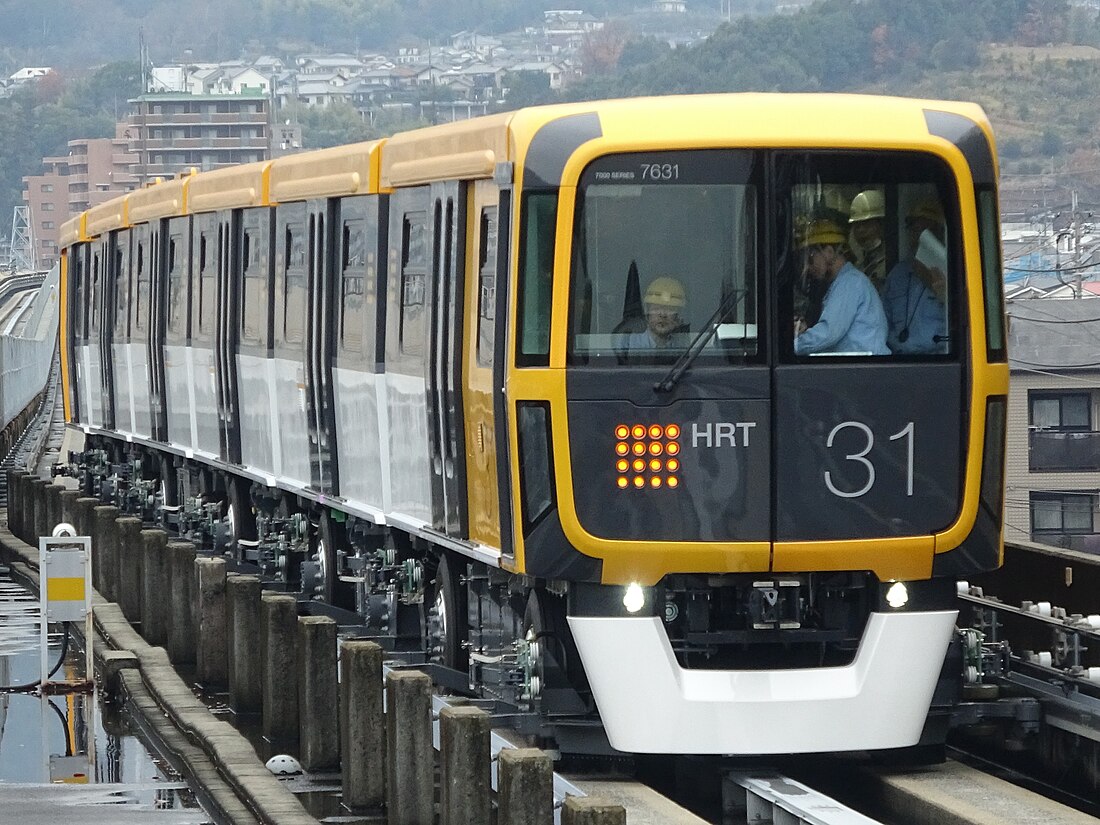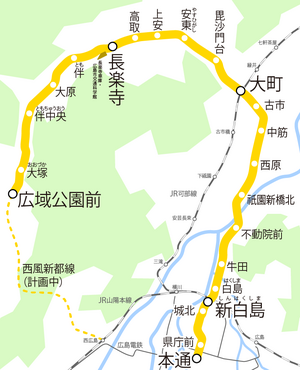Astram Line
Rubber-tired transit system operated by Hiroshima Rapid Transit From Wikipedia, the free encyclopedia
Hiroshima New Transit Line 1 (広島新交通1号線, Hiroshima Shin Kōtsū 1-gō-sen), also known as the Astram Line (アストラムライン, Asutoramurain), is a manually driven[1] rubber-tired transit system operated by Hiroshima Rapid Transit in Hiroshima, Japan. Astram opened on August 20, 1994, for the 1994 Asian Games in Hiroshima. The line connects central Hiroshima and Hiroshima Big Arch, which was the main stadium of the Asian Games.
This article needs additional citations for verification. (March 2017) |
| Astram Line (Hiroshima Rapid Transit Line 1) | |||
|---|---|---|---|
 | |||
 A 7000 series train on the Astram Line in December 2019 | |||
| Overview | |||
| Owner | Hiroshima Rapid Transit | ||
| Locale | Hiroshima | ||
| Termini | |||
| Stations | 22 | ||
| Service | |||
| Type | Rubber-tyred metro | ||
| Services | 1 | ||
| Depot(s) | Chōrakuji | ||
| History | |||
| Opened | 20 August 1994 | ||
| Technical | |||
| Line length | 18.4 km (11.4 mi) | ||
| Number of tracks | 2 | ||
| Electrification | 750 V DC third rail | ||
| |||
On March 14, 2015, a new station, Shin-Hakushima, opened to create a second connection between the Astram Line and the JR lines.
History
Summarize
Perspective
Plans to build a new transit system linking the city centre of Hiroshima with the suburban area to the northwest were first proposed in July 1977.[2]
The third-sector Hiroshima Rapid Transit was founded in 1987, funded primarily by the city of Hiroshima.[2] Groundbreaking for the rapid transit line project began on February 28, 1989, and construction would continue over a five-year period.[citation needed] However, on March 14, 1991, 14 people were killed when a girder collapsed on a section of the line's elevated viaduct near the Kamiyasu station's construction site.[3] The line opened for revenue service on August 20, 1994.[2]
When the line originally opened in 1994, it had 21 stations, of which Ōmachi provided the line's only transfer with a JR West line (the Kabe Line). On March 14, 2015, Shin-Hakushima opened as an infill station between Hakushima and Jōhoku in order to provide a transfer point with the Sanyo Main Line.
In January 2025, the line announced fare increases of up to ¥30 per ride. This is the first fare increase (except for the addition of sales tax as sales tax laws changed) in the over 30 years since the line opened in 1994. These fare increases will take effect from October 2025.[4]
Stations
| Station | Japanese | Distance (km) | Transfers | Location |
|---|---|---|---|---|
| Hondōri | 本通 | 0.0 | ■ Hiroden Ujina Line (at Hondori) | Naka-ku |
| Kenchō-mae | 県庁前 | 0.3 | ||
| Jōhoku | 城北 | 1.4 | ||
| Shin-Hakushima | 新白島 | 1.7 | ||
| Hakushima | 白島 | 2.1 | ||
| Ushita | 牛田 | 2.9 | Higashi-ku | |
| Fudōin-mae | 不動院前 | 4.0 | ||
| Gion-shinbashi-kita | 祇園新橋北 | 5.0 | Asaminami-ku | |
| Nishihara | 西原 | 6.0 | ||
| Nakasuji | 中筋 | 7.0 | ||
| Furuichi | 古市 | 7.8 | ||
| Ōmachi | 大町 | 8.4 | B Kabe Line | |
| Bishamondai | 毘沙門台 | 9.6 | ||
| Yasuhigashi | 安東 | 10.6 | ||
| Kamiyasu | 上安 | 11.4 | ||
| Takatori | 高取 | 12.0 | ||
| Chōrakuji | 長楽寺 | 12.7 | ||
| Tomo | 伴 | 13.9 | ||
| Ōbara | 大原 | 14.9 | ||
| Tomo-chūō | 伴中央 | 16.0 | ||
| Ōzuka | 大塚 | 17.6 | ||
| Kōiki-kōen-mae | 広域公園前 | 18.4 |
Rolling stock
Summarize
Perspective
- 6000 series 6-car EMUs (23 sets)
- 7000 series 6-car EMUs (three sets with 11 sets on order)
As of 2021[update], services on the line are operated using a fleet of 23 six-car 6000 series trainsets (sets 01 to 23) and three six-car 7000 series (sets 31 to 33).[5]
The entire fleet of 24 1000 and 6000-series sets is scheduled to be replaced with a new fleet of six-car trains delivered in two batches.[6] The first of 11 new 7000 series sets was delivered in 2019.[7] The first 7000 series set was delivered in October 2019[8] and entered service in March 2020.[5] The lone 1000 series set have since been retired.[5]
6000 series

The 6000 series trainsets (01 to 23) are formed as follows, with all cars motored.[9]
| Designation | Mc | M | M | M | M | Mc |
|---|---|---|---|---|---|---|
| Numbering | 61xx | 62xx | 63xx | 64xx | 65xx | 66xx |
Priority seating is provided in each car, and wheelchair spaces are provided in the end cars.[9]
7000 series

The 7000 series trainsets (31 to 33) are formed as follows, with all cars motored.[5]
| Designation | Mc | M | M | M | M | Mc |
|---|---|---|---|---|---|---|
| Numbering | 71xx | 72xx | 73xx | 74xx | 75xx | 76xx |
Priority seating is provided in each car, and wheelchair spaces are provided in the end cars.[5]
Former rolling stock
1000 series
The 1000 series trainset (24) was formed as follows, with four of the six cars motored.[9]
| Designation | Tc | M | M | M | M | Tc |
|---|---|---|---|---|---|---|
| Numbering | 1124 | 1224 | 1324 | 1424 | 1524 | 1624 |
Priority seating was provided in each car, and wheelchair spaces were provided in the end cars.[9]
See also
References
External links
Wikiwand - on
Seamless Wikipedia browsing. On steroids.

